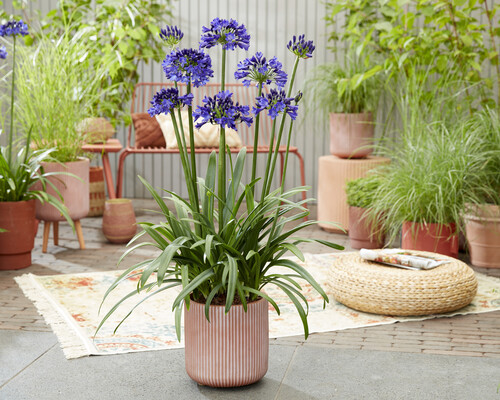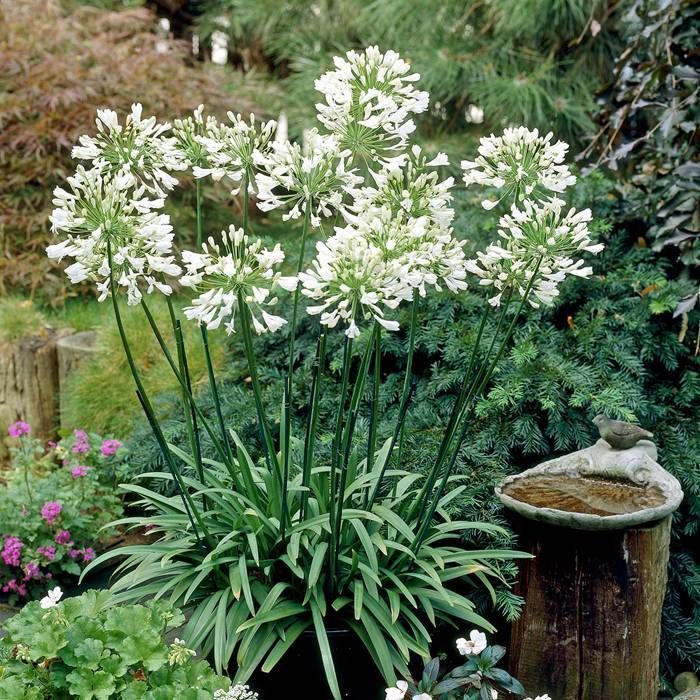Seasonal Agapanthus Care: Getting Ready For Winter and Summertime
Seasonal Agapanthus Care: Getting Ready For Winter and Summertime
Blog Article
Mastering the Art of Agapanthus Care: Important Steps for Healthy Development and Lively Blooms
In the realm of cultivation, the cultivation of agapanthus stands as a fulfilling venture for those that seek to nurture these stylish blooming plants. With their striking blooms and elegant foliage, agapanthus has actually caught the focus of gardeners worldwide. However, attaining optimum development and dynamic blossoms calls for a nuanced technique that includes different vital steps. From selecting the appropriate variety to understanding pruning strategies, the journey towards growing flourishing agapanthus plants is multifaceted and holds the key to opening the full possibility of these botanical treasures.

Picking the Right Agapanthus Variety

When selecting the ideal Agapanthus variety for your yard, consider aspects such as environment viability, bloom color, and growth practice. Agapanthus, typically called Lily of the Nile or African lily, is available in a variety of colors varying from shades of blue and purple to white. Choose a blossom shade that enhances your existing yard scheme to create a harmonious landscape. In addition, take into consideration the climate in your region to make certain the Agapanthus range you choose can prosper in your details problems. Some varieties are much more tolerant of cool temperatures, while others prefer warmer climates. Recognizing the development practice of different Agapanthus selections is crucial for appropriate positioning within your yard. Some ranges have a clumping development habit, ideal for containers or boundaries, while others have a more spreading nature, appropriate for ground cover or mass growings. By thoroughly examining these aspects, you can pick the ideal Agapanthus variety to improve the elegance of your yard.
Ideal Growing Conditions
Thinking about the optimum ecological needs is vital for effective Agapanthus growing. Agapanthus plants are sensitive to cold temperatures and must be secured from frost during winter months.
To make certain healthy development and lively blossoms, plant Agapanthus bulbs at a depth of about 2-4 inches and room them 8-12 inches apart. Mulching around the base of the plants aids retain dampness and reduces weed development.
Watering and Feeding Tips
Preserving proper wetness degrees and providing essential nutrients are crucial elements in the treatment routine for Agapanthus plants. When it involves sprinkling Agapanthus, it is crucial to strike a balance. If overwatered, these plants like continually moist dirt but are susceptible to root rot. Throughout the growing season, water deeply once a week, ensuring the dirt is well-draining to avoid waterlogging. In hotter climates or throughout periods of dry spell, more frequent watering may be required to maintain the soil uniformly moist. Nonetheless, view it decrease watering in the winter to stop waterlogged conditions.
Feeding Agapanthus is necessary for promoting healthy development and respected flowers. Apply a balanced plant food, such as a 10-10-10 formula, in the early springtime check over here as brand-new development emerges. By adhering to these watering and feeding ideas, you can ensure your Agapanthus plants flourish and produce vivid, long-lasting blooms.
Trimming Techniques for Agapanthus
Trimming Agapanthus plants at the suitable times and with proper strategies is vital for keeping their health and advertising optimal growth and blooming. The perfect time to trim Agapanthus is in late wintertime or early springtime prior to new development emerges.
For flowered stems, wait until the flowers have actually withered and after that cut them back to the base. This not just cleans the plant's look however also motivates the development of new blossom buds. Deadheading invested blossoms can additionally reroute the plant's power into producing more flowers as opposed to establishing seeds. However, if you intend to accumulate seeds for propagation, leave some blossoms to completely dry and fully grown on the plant.
Remember to use clean, sharp tools to make accurate cuts and minimize the danger of introducing conditions. Agapanthus. Routine pruning will aid keep your Agapanthus looking healthy and neat while ensuring a plentiful display screen of stunning flowers
Managing Usual Bugs and Diseases
After guaranteeing appropriate trimming techniques for Agapanthus, it is vital to attend to typical parasites and diseases that can influence the health and wellness and vigor of these plants. One typical bug that affects Agapanthus is the Agapanthus gall midge.
Additionally, Agapanthus plants can experience from root rot if they are planted in badly draining soil. By being vigilant and taking timely action against internet illness and bugs, you can aid your Agapanthus plants prosper and produce vivid blossoms. Agapanthus.

Conclusion
In verdict, understanding the art of agapanthus treatment includes choosing the best selection, providing optimal growing conditions, correct watering and feeding, proper pruning strategies, and dealing with typical pests and illness. By adhering to these essential steps, you can guarantee healthy and balanced growth and lively flowers for your agapanthus plants. Bear in mind to frequently check and maintain your plants to promote their total well-being and long life.
To ensure healthy and balanced growth and dynamic blossoms, plant Agapanthus bulbs at a deepness of about 2-4 inches and room them 8-12 inches apart. By adhering to these watering and fertilizing suggestions, you can guarantee your Agapanthus plants grow and generate vibrant, durable blooms.
One usual bug that affects Agapanthus is the Agapanthus gall midget. In addition, Agapanthus plants can experience from origin rot if they are planted in inadequately draining soil. By following these necessary actions, you can make certain healthy growth and dynamic blooms for your agapanthus plants.
Report this page